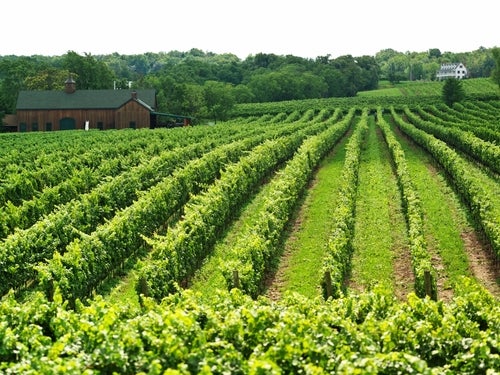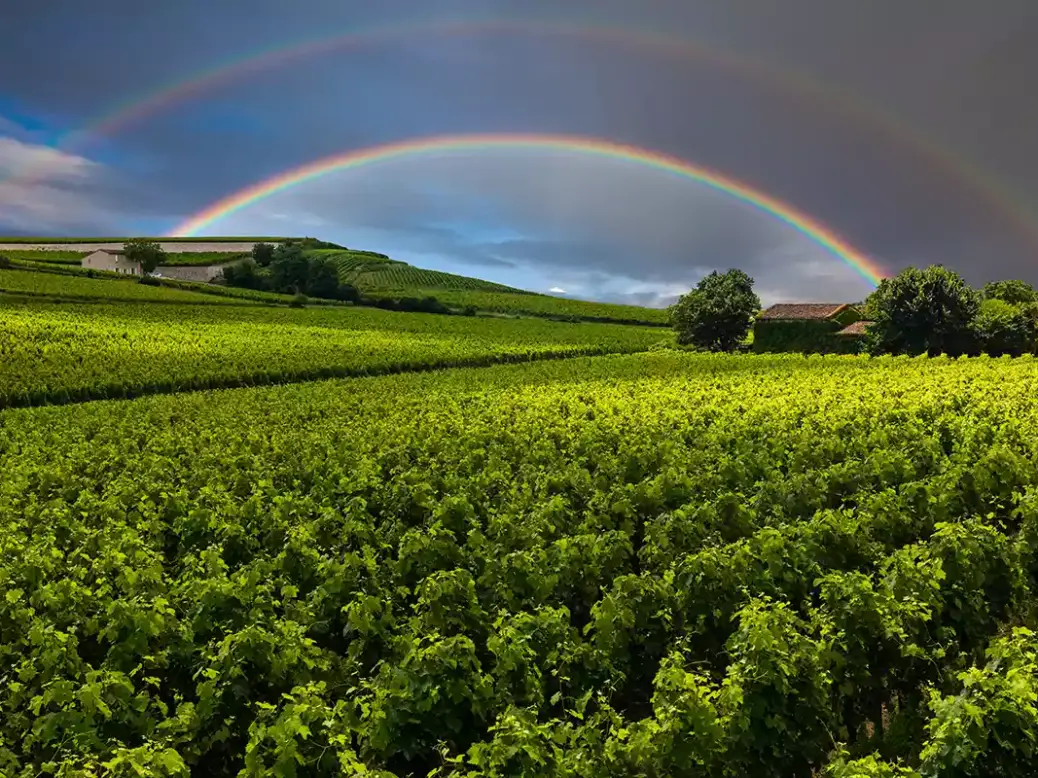
The region may be battling challenges on numerous fronts, but the 2023 Bordeaux vintage, while seldom scaling the heights of its immediate predecessor, nonetheless offers many very elegant, refined wines of great potential, with a decidedly fresh “contemporary classical” feel, says Simon Field MW.
The red carpet snakes through the vat room, past the dazzling stainless steel, and then into the barrel warehouse, expensive barriques lined up, and finally into the tasting room. Troplong Mondot had transformed its en primeur tasting in April into the Oscars, a confident welcome for the 5,000 or so who had come to taste the young wines and, implicitly, to lend support to an apparently faltering mechanism. Smiles and laughter, a few tongues in cheeks, and the prospect of some excellent, if young, wines. The supply-side logic of the primeurs—which has been focused on demand exceeding supply and on subsequent asset appreciation—is being questioned. The red carpet symbolizes a gentle snub to all that—a statement of hubristic self-belief and a playful endorsement of a highly successful sales vehicle. But has it worked?
The widening diaspora between the quality of the product and the fragility of the mechanism comes into even sharper focus in a year that, though prized and classically structured, does not scale the heights of its forebear. The purpose of this report is primarily to focus on the vintage itself, but it would be unwise to ignore the commercial backdrop, albeit a backdrop that covers but a small, rarefied part of the greater Bordeaux market and that does not give sufficient attention to some of the issues on the less glamorous side of the marketplace, where more than 8,000ha (nearly 20,000 acres) of vines have been uprooted and where the ever-more prevalent scourge of mildew is less likely to be treated as a result of lack of resource. Troubled times, then. And yet the Bordelais have never been making better wine, as what follows will hopefully celebrate with no lack of enthusiasm.
2023 Bordeaux overview
So, how was it? There follow a few aperçus, a season-by-season report, then a pilgrimage from the vineyard to the winery, and finally a few more observations from those involved. One can never have too much of the vox populi, especially if the vox in question is that of a winemaker, all gleaned over four weeks from April 9 until May 7, which witnessed, inter alia, a weekend with temperatures of 84˚F (29˚C), a week of near-freezing dawn temperatures, and a battle against frost, heavy rainfall, and the ever-present risk of mildew. At one point, indeed, the growers were anxious lest temperatures rise too much, for fear of it triggering the more rapid onset of mildew. All the seasons in one month, then, and, in microcosm, a rehearsal of today’s threats to this most Atlantic of vineyards.
Celebrated consultant Thomas Duclos neatly summarizes the paradox that was 2023 Bordeaux: “It was dry yet wet; it was warm yet not warm; it was a vintage of the highest standard deviations.” What on earth does he mean? In short, 2023 was one of the warmest and one of the wettest of years, the interplay between the two neither sequential nor especially logical. A whimsical vintage, with “heterogenous” winning the prize as the most-cited descriptor. 2022 is now widely described as “exceptional,” leaving 2023 to take the consolation prize of being merely “great.” Faint praise… or not that faint? Hard to say, and I, for one, would like to make it clear that I love a lot of the wines, their notes of “contemporary classicism” most evident in lower levels of alcohol, firmly chiseled tannins, and fine, balancing acidity—all chiming happily with this Anglo-Saxon palate but also, I believe, with a growing number of others around the world. And with some of the key players, too. For Axel Heinz, who has now completed his move from Ornellaia, 2023 Lascombes has a “neo-classical” feel, with textural roundness and ripeness, harnessed by technology but also with only moderate intensity and alcohol. Vincent Millet at Calon-Ségur agrees, even volunteering a preference for the younger of the two wines: “In 2022, it was all about climate; in 2023, it is the terroir that speaks, and in every single plot you can really get to know the DNA of St-Estèphe. This is what I like.”
An exciting vintage in this respect, then, described by Guillaume Thienpont as “intemporel ” (timeless), because of an effortless juxtaposition of “classic freshness, tension, and bite, but also core muscle and the season’s gift of glorious fruit.” If the winemaking (he describes it poetically as “le pilotage”) has been refined, it is nothing more than that—
a refinement—and the core of classical, finely textured Bordeaux remains, pure and not so simple. Given that Guillaume has made not only Vieux Château Certan but also Le Pin, he is reasonably qualified to make such a definitive statement. In more prosaic terms, 2023 Bordeaux can be summarized as a year of relatively low pH levels, modest alcohol levels, the greatest successes with Cabernet Sauvignon on the Left Bank, and Cabernet Franc on the Right. The seasonal patterns, with mildew plaguing their core and then late heat spikes that threatened but failed to deliver drought, favored the later-ripening Cabernets. A little more vigilance is required when assessing the Merlots of the Right Bank, and in general, conditions were easier the farther up the Médoc one ventured. An especially successful year, then, for St-Estèphe, Pauillac, and much of St-Julien. Elsewhere, too, of course, but with less uniform excellence.
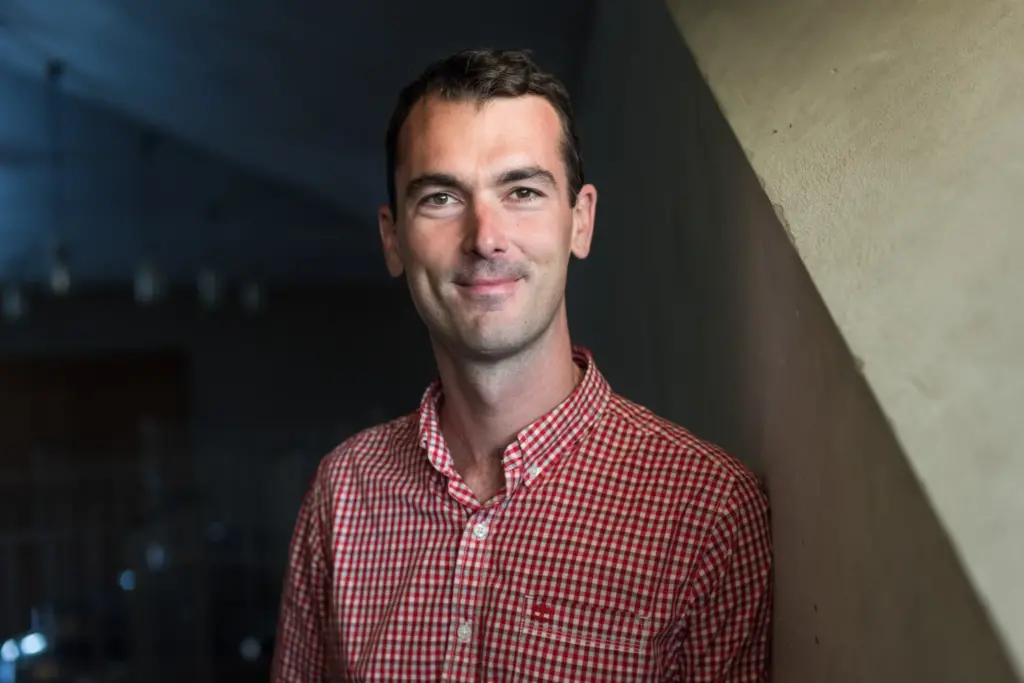
Before a deep dive into detail, here are a few top lines. 2023 saw an overall production in AOC Bordeaux of 384 million liters, down from 411 million in 2022 but not far from the ten-year average of 390 million. The average over the previous decade (2010–20) had been 581 million liters—appreciably higher. Overall, the largest drops have been in AOCs Bordeaux and Bordeaux Supérieur, a result of both economic plight and, not unrelated, the lack of ability to deal quickly with mildew, as was the case in 2018 and, even more so, in 2023. Yields per hectare are therefore down significantly in generic appellations but actually up in the privileged enclaves; St-Julien, Pessac-Léognan Blanc, and St-Estèphe all averaged yields above 50hl/ha. It would be incorrect, therefore, especially at the prestige end, to say that 2023 was a short crop. In 2023 overall, 81% of the wine was red, 11% dry white, 4% rosé, and 1% sweet. Merlot is still planted in nearly twice as many vineyards as Cabernet Sauvignon, but plantations of both Cabernets are on the increase, and there is growing appreciation of the resilience of Petit Verdot. With the main white grape varieties, there is near parity between Sauvignon Blanc and Semillon, both with their champions, for different reasons. As we shall see, 2023 was a good to very good vintage for the dry whites and a very good one for the sweet wines.
Sun and rain
In terms of sun and rain, the statistics confirm the observation made above that 2023 was both wet and warm, a vintage of contrasts if not of extremes, a vintage of nuance and unpredictability rather than record-breaking intensity—a vintage that is hard to summarize, therefore, which is probably part of its appeal. The average temperature in the growing season was 66.9˚F (19.4˚C). (It was 67.3˚F [19.6˚C] in 2022, and 63.9˚F [17.7˚C] in 2021.) The rainfall from March to September was 16.9in (428mm) (10.9in [278mm] in 2022, and 18.5in [469mm] in 2021). Total annual rainfall for 2023 was 48in (1,219mm), compared with 25.2in (639mm) in 2022 and 34.8in (885mm) in 2021. The increase on even 2021 is striking. Warm and wet then, with average temperatures in June 5.4˚F (3˚C) higher than the ten-year average (which fostered the mildew), heat spikes at the end of August, then again on September 4 and 7—all of which allowed the Cabernets to ripen fully and vindicated all those who decided to wait to harvest these grapes. The warm period, belated though it was, distracted the grapes into investing energy in fruit rather than vegetation.
The key issue at this stage—less discussed, maybe, than the earlier mildew—was the risk of sunburn. If one had cut back the foliage to keep the damp at bay, might there not be a risk of damage to the grapes when the sun started to burn? There might, indeed. The management between these apparent contradictions was but one of several subtle conundrums posed in 2023. Philippe Bascaules at Château Margaux is entirely earnest when he discusses the desire to reorient (north–south) all of the property’s vines and even to introduce an adaptable mesh shield to act as a giant parasol on the sides of the most exposed vines. Such sun protection is not yet permitted by INAO, he smiles, but he hopes that the authorities will adapt with the changing conditions. Guillaume Pouthier at Les Carmes Haut-Brion addresses the issue from another angle; water management is key for him—from the manipulation of the water table with cover crops, through the pruning regime to preempt evapotranspiration, to the canopy management during the season. Water and sunshine were both abundant in 2023, for better and for worse.
Winter
A warm 2022 fall continued the familiar voice that caroused a highly impressive vintage. The winter was cool and calm, with enough precipitation (17in [434mm] from November to March) to replenish water reserves after the exceptionally dry 2022 growing season. This was significant in itself, setting up the season favorably and, as it turned out, serving to shield the ensuing months from risks of drought and hydric stress, without undermining the possibility of what one might describe as hydric tension—deemed a positive in terms of the structural genesis of the grape and then the wines themselves. Tension is better than stress, it seems.
Spring
Spring was early and humid, with what Pouthier describes as “a few shivers” of rain. Nothing to excess, however, and both budbreak and flowering were pretty much in accordance with normal, earlier in some places—in Pessac, for example, where the good shepherds at Smith Haut Laffitte were obliged to discourage their llamas from grazing in the vineyards by the end of March. These crucial stages of the vine cycle occurred later in other places, however, budbreak at Lafite not taking place until April 5–19. Already the patterns were hard to predict, itself presaging the ultimate heterogenous nature of vines and wines alike.
Thereafter, a rapid heat accumulation, and if both April and May notched up an average of 1.8˚F (1˚C) above the norm, then June, as we have seen, was a full 5.4˚F (3˚C) higher—significant, therefore. This was allied to further precipitation and, with the onset of mildew, the start of the problems. Semi-tropical daytime conditions were exacerbated, according to Cyrille Thienpont at Pavie Maquin, by nighttime temperatures that were significantly higher than usual. The warm air lingered, and the rain droplets encouraged the downy mildew. Late May and early June were the worst affected, and Merlot, on an earlier cycle than the Cabernets, the most vulnerable. The combination of humidity and heat naturally encouraged vigor in the vines and led to some leaf-plucking and green-harvesting, to allow the canopy to breathe and also, quite literally, to stop the rot—black rot, in this instance, another incipient danger in such conditions. The copper-based treatments—described by Jean-Jacques Bonnie and others as an “application”—were only effective until they were washed away by the next downpour. Resources, human, mechanical and chemical, were stretched, and many were overwhelmed by the pressure of it all. Yields were reduced, sometimes significantly, and even larger properties, such as Smith Haut Lafitte suffered significant yield reduction, with 40% of its Merlot crop destroyed. The effects, however, were localized, and as with the storms of 2021, the veil of rainfall set its own unpredictable path, hardly touching, for example, the plateau of Pomerol. On the other side of the river, Pauillac was also spared, in relative terms at least. Domaines Barons de Rothschild Lafite therefore had reason to be cheerful, not only at Lafite but also at L’Evangile.
Summer
The tumult did not arrest progress in the sense that the relative warmth (albeit humid warmth) did not set back the calendar, and véraison was also earlier than sometimes; its onset was rapid, and it was generally completed in between ten and 12 days—by July 17 for the Merlot, and by July 25 for the Cabernet Sauvignon at Haut-Bailly, for example. Elsewhere, and entirely in keeping with this far from homogenous vintage, it took a little longer, sometimes lasting a full month.
Thereafter, a slow but gradual increase in temperatures. If the first half of August was relatively temperate, the latter weeks and early September saw the year’s only significant heat spikes. No 104˚F (40˚C) this time, but several days around 95˚F (35˚C). Cyrille Thienpont—who now makes Domaine L’If, as well as Pavie Maquin—recalls that in St-Emilion there were two “mini-heatwaves, the first running August 18–24, the second, September 1–7. He adds that neither spike actually caused heat stress or provoked anything like a drought. The calls for relaxation of the rules concerning irrigation, which had so punctuated the 2022 growing season, were not to be heard this year.
According to Matt Turmer at Pape Clément, the slow burn of the season had differing effects for the two key red grape varieties, Cabernet Sauvignon, the late-ripener, benefiting from nature’s greater generosity as harvest drew nearer. For all that, throughout the summer, there were significant temperature variations, sometimes from one day to the next, sometimes by as much as 27˚F (15˚C).
Pierre-Olivier Clouet at Cheval Blanc singles out two spikes in August (23 and 25), when the temperature rose perilously close to 104˚F (40˚C), causing slight berry burn on the sunset side of the vines. No aromatic effect was noted, however, and in fact there was more rain than usual (2.6in [65mm]) in August, so no threat of a canicule (a heatwave).
This phenomenon, allied to the relatively cool start to August (its average temperature down from an exceptionally high 79.7˚F [26.5˚C] in 2022, to a more normal 69.8˚F [21˚C] in 2023) did finally slow down the cycle, which by its end could no longer be described as “precocious.” This was exacerbated by relatively cooler nighttime temperatures, the opposite of those that had marked out the spring conditions, which were favorable for preserving acidity and synthesizing polyphenols in the reds.
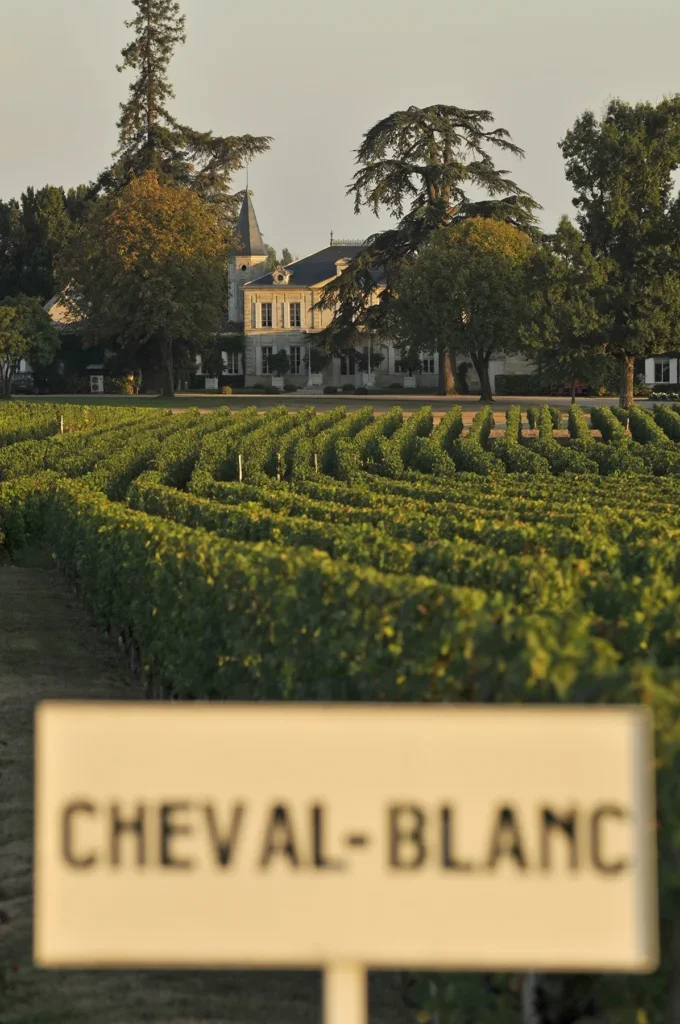
The longer hang-time was mainly reserved for the reds; most of the white grapes were picked in the second half of August—rightly so, as it turned out, because the ensuing heat episodes may well have compromised the acidic backbone that underwrites their bright personality. Even the late heat spikes were mostly played out under overcast skies, so the optics for sunshine itself were significantly less impressive than those temperatures. This had a bearing on the nature and “quality” of the photosynthesis.
The 2023 Bordeaux vintage may therefore be summarized as a season of two halves: In the first half, there was mildew and precipitation, danger of dilution matched by lack of hydric stress; the warm weather of the second half did not bring on the latter, but it did forestall the former.
Mildew
It is perhaps worthwhile making a brief digression to consider mildew, which, above all others, framed the identity of the vintage. This is all the more relevant, since the threat is already imposing itself once again this year, in 2024.
2023 Bordeaux may well be remembered as a vintage of the haves versus the have-nots. It was, as Antoine Mariau at Nénin commented, “le millésime des riches,” because the cost in terms of resource and labor was immense—but if such a cost could be met, then the damage would be minimal. With mildew, there is no escaping the effort required to fend it off; the copper solution has to be reapplied persistently: extra time, more workers, more cost, and quite simply beyond the means of a large number of producers in badly hit areas such as Entre-Deux-Mers and Castillon Côtes de Bordeaux. Those with the means were spared—or at least their vines were, which is probably tantamount to the same thing.
The mildew came as a result of a gradual buildup of heat on and after budburst. Both 2018 and 2021 were also affected, but less persistently and less dangerously. The temperatures rose gradually as spring advanced, with June the cruelest month in this episode, its temperatures highly unusual, which, allied to the persistent precipitation, resulted in a flurry of preventive activity. Pomerol got off reasonably lightly (such things are always localized over such an immense vineyard area as Bordeaux), but Juliette Couderc at L’Evangile does not hold back in describing “une semaine d’horreur” (a week of horror) that ran June 19–24, dropping 2.7in (70mm) of rain and necessitating four consecutive treatments. Those without resources lost a significant tranche of the crop, and in their cases, the hyperbolic newspaper articles describing “decimation” and the like were not without justification. Even more prestigious (and ostensibly very wealthy) properties such as Smith Haut Lafite (run biodynamically) endured losses. Fabien Teitgen, the long-standing and highly successful technical director there, shrugs, saying that in the face of nature’s whim he is but “an open-minded peasant.” One may well only agree with the first half of that self-characterization.
Mildew, even if kept at bay early on, can always return later in the season, as was the case in 2018. In fact, there was little recurrence in 2023, but its incipient threat will have a bearing on subsequent leaf-plucking (especially since the humid conditions encourage extravagant foliage) and green-harvesting.
Very different outcomes to the mildew threat in 2023, then, largely down to means rather than incipient expertise. Christian Moueix speaks for many when he praises the “exemplary and diligent reactive spirit of all of our teams who were able to keep the assault at bay and, ultimately, to harvest a crop that was normal in terms of both size and quality.” Once vanquished, the mildew—unlike the heat stress of 2022—had minimal bearing on the personality and quality of the vintage. It served, however, to underline the caprice of nature and the need for vigilance.
Viticulture
One of the most significant features of the Bordeaux of 2023/24, compared with the Bordeaux of a decade ago, centers on precision in the vineyard, be it minutely focused drone analysis of each parcel of vines, as at Giscours and Pontet-Canet, among many others, or an ability to engage in rapid response to the slightest meteorological shift. Noëmie Durantou at L’Eglise-Clinet is one of many who shows me how GPS apps monitor precise plots for humidity and temperature—this in April, when the danger of frost is very real. There is a spirit of enquiry at large, which may not correspond to one popular image of the Bordelais as hubristic and entitled. Nothing could be further from the truth. Pragmatism is key, as with, for example, the philosophy of green-harvesting or leaf-plucking, or the use of clones and, increasingly, massal selection to ensure that the grape varieties in play have either an historical imprimatur or a well-rehearsed reason for being cultivated here. Farming by parcel is key, and most producers have followed the lead of Cheval Blanc in having intimate knowledge of the plots in question—54 autonomous parcels in that instance. Axel Heinz at Lascombes is able to demonstrate precisely how each parcel fits in with each of Margaux’s famous terraces and, even more interestingly, how the vineyard has expanded nearly sixfold from its original 1855 classification. (The debate continues!) As an aside, the parcels currently identified as the “best” are almost exactly those that were included in the 1855 taxonomy.
Everything is scrutinized, be it the rootstocks in play and their interface with increasing instances of hydric deficit; be it the use of cover crops the better to exploit water resources and encourage optimal transpiration; be it the use of agroforestry (Cheval Blanc again leads the way, with Clare Villars-Lurton’s Haut-Bages Libéral also in the vanguard); or be it the orientation of the vines (a topic of interest not only at Château Margaux). Everything is open to question, focusing in 2023 on optimizing the cycle in a year that was mildew-affected and experienced a relatively cool mid-season and then, late on, unprecedented (in their timing rather than their intensity) heat “episodes” to define the personality of the vintage.
Grape varieties and harvest dates
One could expand almost exponentially on many of the topics touched upon in the vineyard. It may be worth highlighting the correlation between the cycle as outlined and the grape varieties that fared best in 2023 Bordeaux. Overall, the meteorological patterns favored the Cabernets, especially for those who held their nerve and waited long into September before venturing out to harvest. Some, but by no means all, of the Right Bank Merlots lack mid-palate harmony, and while there are few that might be described as hollow, only the very best (from the blue clay of Pomerol or the limestone plateau of St-Emilion, for example) excelled with anything like the flourish of 2022. More of a year, then, for Cabernet Franc (or Bouchet if you are Château Lafleur!) and for statements about increased plantings thereof for the future; Vincent Priou at Beauregard and Mickaël Obert at Gazin are but two who are planting both of the Cabernets. At Figeac, Frédéric Faye was pleased with both of its Cabernets in 2023—the Franc, for its “harmony and finesse,” impressive, he says, for such a capricious variety, and the Sauvignon proving well suited to some of Figeac’s atypically gravelly soils, the small berries adding concentration and focus to the final assemblage. It would, of course, be foolish to suggest a sea change in the profile of the Right Bank wines, but the increased interest in the Cabernets and in Bouchet (Ausone, Angélus, and Le Dôme were all excellent in 2023) maybe underlines a subtle recalibration, and yet one that, as so often, is not without historical precedent.
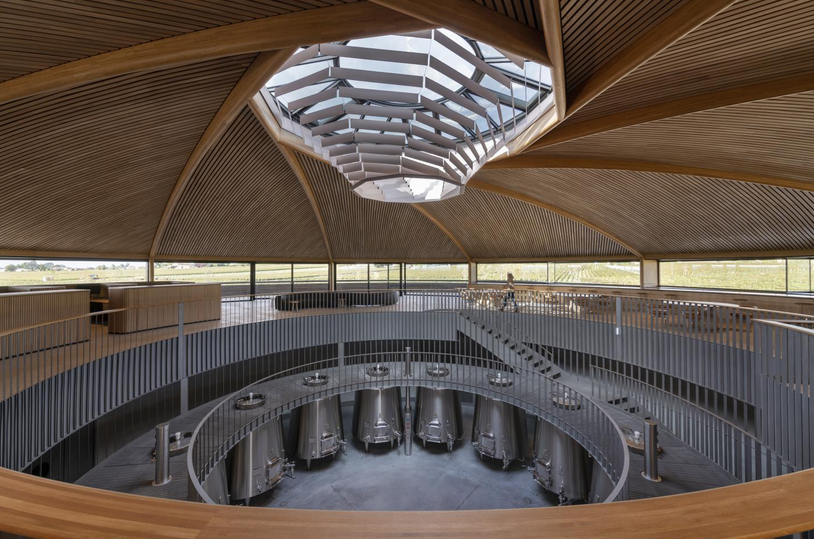
There is less by way of a sea change on the Left Bank: Husbandry in the vines, allied to proximity to the estuary, were, as usual, key factors. So were the timing and length of the harvest itself, with many—Philippe Blanc at Beychevelle, Mathieu Bessonnet at Pontet-Canet, and Jean-Pierre Delmas at Haut-Brion among them—experiencing their longest-ever harvest period. Delmas noted the warmest September since 1820, with temperatures above 86˚F (30˚C) for 12 days. Having started the harvest for the white wines on August 21, he did not pick the final Cabernet Sauvignon until October 4—quite a gap. Bruno Borie at Ducru-Beaucaillou was of a similar disposition; having brought in the Merlot September 8–15, he decided to defy the poor weather forecast and to wait for his Cabernets—a brave and wise move, as it turned out: The poor weather did not materialize, the hang-time was extended, and the ripeness and complexity of the Cabernet enhanced. Bessonnet at Pontet-Canet decided to pick its Merlots earlier than usual, but when it came to the Cabernets, the predicted 4in (100mm) of rain did not fall (it was an inch [25mm] at most) and the Cabernets were picked from September 28 to October 10. “Un pari réussi” (a successful bet) is how he describes this happy outcome. But might this dichotomy lead to textural complications and a lack of harmony in the final blends? Not so, according to Faye, who discerns a winning marriage of freshness and complexity in his final blend at Figeac. At Ducru, meanwhile, Borie extols both “succulent” fruit and a pleasing lift on the finish of his wines, this felicitous juxtaposition perhaps characterizing the vintage in general.
Vinification and vessels
Of the many essays that could be written on these topics, the most interesting brace would focus on extraction methods, gentle as never before, and on the vessels employed for maturation, more varied than ever before.
2023 Bordeaux may have been warm, but it was essentially an Atlantic (“classic”) vintage. This is the source of its enigmatic appeal but also the reason for vigilance in the winery. The musts were not to be treated in the same manner as 2022… or 2021… or, in fact, like any other recent vintage. Therefore, both the length and the temperature of maceration had to be judiciously invigilated. And before the grapes even got to the vats, the mildew threat had necessitated an unprecedented rigor when it came to sorting: empirical sorting in the vineyard, then optical sorting on reception, and finally densiometric sorting to eliminate anything remotely blighted or affected by millerandage or dust or anything else, for that matter. Olivier Bernard summons up his inner Duc de La Rochefoucauld (he of the Maxims) with his own pithy summary: “We were able to make choices from choices already made.” Quite!
There was similar focus in the vat room, needless to say. Jean-Claude Berrouet recommended at Clos Fourtet an approach that was widely followed: delicate manual pigeage, fermentation temperatures that did not exceed 79˚F (26˚C), a modest length of cuvaison (just over three weeks), the malolactic in tank rather than barrel, and a reduced use of new oak (40% in this case). There is, he says, an inverse relationship between the putative alcohol levels and the weight of the hand on the tiller. On the other side of the Gironde, Stéphanie de Boüard-Rivoal at Angélus advocated a ten-day cold-soak (in the name of aromatic purity, depth of color, and ensuing fruit definition), then a longish, cool fermentation (71.5–73.5˚F [22–23˚C]) is definitely on the low side), with minimal use of sulfur dioxide; all this despite the thick skins of the grapes and the power of their inherent structure. In terms of élevage, there is significant use of foudres (30hl) for the Cabernet Franc used in the senior wine, along with the more traditional 22 months in new barriques.
The use of new wood has clearly been reduced by many producers (even Pape Clément no longer employs 100% new barriques), and the cooperage generally moderated with regard to the tightness of the grain or the toasting of the wood. Sometimes—almost paradoxically—the fermentation tanks are now smaller (see the new winery at Branaire-Ducru), but the maturation vessels are larger and more varied in provenance. Examples abound: Stephen Carrier at Fieuzal uses more 400-liter barrels than previously for its Merlot; Matt Turner at Pape Clément uses barrels from Austria; Ben Sichel at Angludet uses 40% amphorae; up to 30% of the wines at Les Carmes Haut-Brion are aged in 18hl vessels—one could go on… Suffice it to say that the long vistas of neatly regimented barriques—a symbol of success if ever there was one—has now been somewhat compromised by the infringement of common sense. Once again, there is more than a whiff of humility and openness at large.
2023 was not especially challenging; every vintage has its challenges. The point is that the modus operandiis now realigned; the product comes first, and some of the gloss that has grown up around its mythology is less thick. This can only be healthy.
Comparisons are odorous
And so, to the fun bit, when winemakers are invited to summarize their feelings and to offer comparisons. Generally, the protocol is first to say that there is no comparison to be made to the vintage in question, since it is clearly unique; then, a few seconds later, a comparison is made, and everyone is happy. At Léoville-Las-Cases, they are masters at the game, and having compared their 2022 to the 1870, they advise that the 2023 is a little more similar to pre-Revolution 1771—a perfect challenge, in that it is impossible to challenge. Closer to today, the consensus seems to favor 2019, structurally, given that the wines are less (overtly) ripe than 2020 or 2018 but have more vigor and complexity than, say, 2017 or 2021. Carrier at Fieuzal provides a blind tasting of a few of the contenders, and it seems that, although 2019 is a strong candidate, the two vintages there that most closely approximate to 2023 are, in fact, 2014 and 2016. 2023 sits somewhere in the middle. For Faye at Figeac, the closest comparison is indeed with 2019, but he adds that the aromatic focus of its Cabernet Franc is such as to elevate 2023 Bordeaux in the hierarchy. Only 2022 is better, he surmises.
And so it goes on. Marielle Cazaux at La Conseillante raises the stakes in comparing it with both 2022 and 2020 but goes on to advise that 2023 is more approachable than either. She discerns something Proustian in its classicism, the aromatics recalling her childhood home. Meanwhile, at Beauregard, Priou steps back a little further, celebrating the “touch of austerity” in 2023 that recalls for him 2008 but also the elegance and length that remind him of 2016. One could cite many other examples; we stated at the beginning, however, that 2023 is rather heterogenous in personality, and though this does not extend to full-blown schizophrenia, there is certainly an intangible charm evidenced, which does not bear much by way of comparison. And that is, perhaps, as it should be.
Saskia de Rothschild, for her part, shuns comparisons and instead invites tasters to assess the vintage by a combination of tasting and then assessment of printed ink-blot cards that have been created by psychologist Hermann Rorschach. Having tasted, for example, 2023 L’Evangile, one charts one’s reactions to an abstract print called the “Blue Clay Arrow.” The interpretation of the picture opens up the interpretation of the vintage. All very Freudian. All very fascinating, imaginative, and insightful.
Back down in the realm of the senses, one has to acknowledge that the arrow—blue or otherwise—is in a permanent state of evolution and that a multiplicity of interpretation should not in any way undermine the key characteristics of a vintage. Remember M Duclos’s pithy summary rehearsed above—“dry yet wet; warm yet not warm”—and you will not be too far away from the vintage’s innate contradictions.
The medium is the message
Discussion of what may be a broken model—in apparent contradiction of both the quality of the wines and the record-breaking attendance during en primeur week—is rife and best rehearsed elsewhere in “real time.” Suffice it to say that it is important to remember that the primeur system is a small if prestigious part of the Bordeaux offering and that it has, over the past three decades, proved both extremely successful and highly resilient. Whether or not the particular circumstances in 2024 will prove life-threatening, remains to be seen. The backdrop is far from straightforward, however, with the geopolitical framework blighted by war, a lack of certainty in Asian markets, and the economic fabric stretched by both inflationary pressures and high interest rates, not forgetting the ever-more pressing issue of overstocks. One thing is clear: The négociants, until now able and willing to underwrite the system, are no longer inclined to do so—
at least not to such an extent.
Early indications seem to point to the fact that the patient struggles on, buoyed by lower release prices. The 2023 Bordeaux primeur campaign is, in a sense, not dissimilar from those of 2008 and 2019, both, for different reasons, resuscitating a moribund market. The danger, however, is that in the source of the remedy might reside the ultimate harbinger of decline. By releasing Lafite at 31% less than 2022 (Lynch-Bages was also 31% down; Haut-Brion, 39% down; Las-Cases, 40% down; and so on and so forth), surely there is a danger not of recalibration but rather of deflation. If the market will only “accept” prices lower than any secondary market offers, then maybe this will have such negative impact on the model that it will cease to be economically plausible. In the world of fine wine, supply-side dominance is key; otherwise, the term “fine wine” becomes redundant in the sense that the product, now demand-led, becomes a commodity. This will not do. Cleary a debate for another time, perhaps in The World of Fine Wine, but of particular relevance to Bordeaux en primeur—the most artificial and therefore most vulnerable fine-wine selling edifice of them all.
Early reports would seem to indicate that the wines that have undercut the secondary market have done well, the quality of the ’23s, while not in the realms of the ’22s, deemed good enough to prop up the edifice thus. It is not as if the alternatives are clearly doing significantly better. (Latour is not involved in the en primeur system and is currently selling its 2017; Palmer is majoring on its “N-10” anniversary ex-cellar releases.) The model, for all that, is very fragile.
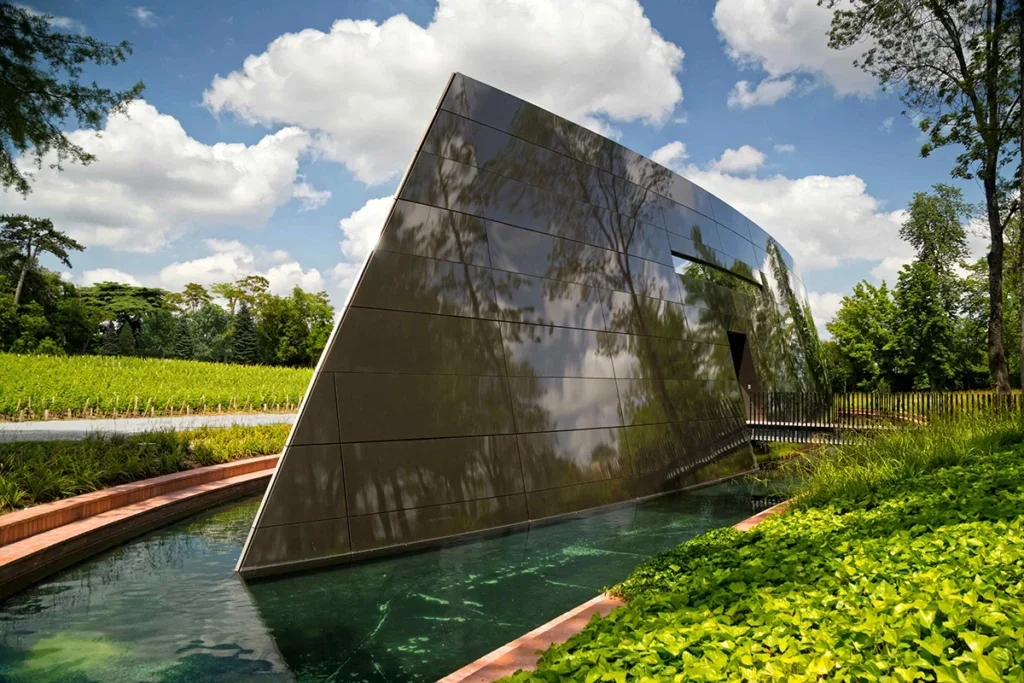
Whites and sweets
Overall, the cooler mid-season conditions favored the whites; early harvests preserved ripeness and underwrote freshness, without sacrificing matière or structure. Appreciable day/night variation maintained the tension and ensured that both malic and tartaric acidity were preserved, with no post facto acidification required. In addition, as with the reds, more “sensitivity” to the influence of both the fermentation and the maturation vessel, marked increased use of concrete, amphorae, and larger vats—all in the name of preservation of structure, all the more important in a year such as this. The same may be said for the use of enzyme cultures and the practice of bâtonnage, neither shunned completely nor overbearing. We want our Pessacs to taste of Pessac and not of wood, and we want the differences between, say, Haut-Brion Blanc and La Mission Haut-Brion Blanc, to stand out. This they do, the former generous and expansive, the latter taut and tightly sprung. An impressive vintage for the whites, subtle above all, but once again with a real sense of place and grape variety evidenced. Witness, for example, the differences between Les Champs Libres, Lilium de Climens, and La Garde Blanc—three examples from three completely different enclaves and all with vital and distinctive personalities. Not forgetting, of course, favorites such as Domaine de Chevalier and an especially impressive Smith Haut Laffitte Blanc. There is, in short, a lot to like about the dry whites in 2023.
The sweet wines are generally very good indeed, the harvest carried out rapidly and efficiently, with yields, thankfully, on a par with 2022 and appreciably higher than in the desperate 2021. Taking a long view, the main difference between today’s harvest and that of 20 years ago is today’s need, once the botrytis has set in, to harvest at great speed. In 2023, the onset was uniform and took place in the first week of October (“a massive attack,” was how Jean-Jacques Dubourdieu at Doisy-Daëne described it) and the number of picking outings (les tris) was far fewer than usual, with one or two all that was required, itself posing logistical problems when it came to ensuring that there were enough pickers. At some properties, however, especially those with more Sauvignon Blanc (Semillon now makes up 75% of the vines, we should remember), there may have been preliminary tris, generally, admits Laurier Girandot at Coutet, for grapes that were passerillés (shriveled, but not by botrytis) rather than actually nobly rotten. In general, however, 2023 witnessed a fast and furious harvest in early October, and one that was finished well in advance of the heavy rains that came on October 18. Yields, averaging 12.5hl/ha, were a little down on both 2022 (14.5hl/ha) and the ten-year average (14.2hl/ha), but not back in the disaster zone of 2021 (3.5hl/ha), when all everyone could talk about was the urgent need for the introduction of a new appellation for dry Sauternes.
A good sign, surely? Simon Deleporte at Lafaurie-Peyraguey thinks so. This is only his second vintage, and even if he didn’t quite manage to achieve the phenomenal level of residual sugar of 2022 (225g/l!), he was happy enough with the 180g/l that he has notched up. Despite not quite scaling the heights of indulgence of 2022, 2023 is being recognized as a powerful, structured year, more in the vein of, say, 2005, 2009, and 2015 than more “elegant” years such as 2014 or 2011. There is, of course, a healthy constituency who favor the more delicate and elegant style, including Girardot at Coutet, who goes against the flow a little when he says that his 2023 is most like 2014. It does not lack elegance, for sure, and the same can be said for the very classy Climens, thereby perhaps underlining the traditional differences between Barsac and Sauternes, stylistically speaking.
François Amirault, the long-serving technical director at De Fargues, points out the “new” dilemma in making Sauternes today, in that the grapes are fully mature far earlier (the middle of August), but one still has to await the rains and the onset of the noble rot. There will be a thickening of the skins in the interim (especially when the interim is as hot as it was in August 2023) and a degree of degradation of both malic and tartaric acid. This may jeopardize both the efficiency of the botrytis attack and the resulting profile of the wine; it will also make the task of achieving successful balance between residual sugar and alcohol by volume more challenging. This balancing act once again calls upon variables and explains the multiplicity of styles evidenced in what, prima facie and given the uniformity of the onset of the noble rot in 2023, would appear to be a fairly homogenous harvest. Overall, however, the quality is excellent.
Conclusion
2023 Bordeaux is a fine vintage; the best wines are elegant, refined, and with no lack of potential. The interface between acidity and alcohol is tilted a little more to the former than in 2022 or 2020, and yet, paradoxically, there is a generosity of fruit and a ripeness of tannin that defies any overly nostalgic comparisons. Thus “new classicism” or “contemporary classicism” are the best descriptors, since they implicitly doff to the subtle and ongoing changes in vineyard and winery alike. This most traditional of regions, with the unremitting influence of the Atlantic Ocean, is especially vulnerable to climate change. The combination of warmer and wetter springs is increasingly tricky in Bordeaux, to which the recurrence of mildew in 2024, possibly even more virulent than in 2023, bears witness. Far from resting on their laurels, the Bordelais are battling constantly against possibly insurmountable forces. The doldrums of the en primeur market is but one of these, and probably the easiest to remedy. Challenging times ahead, then. All the more reason to appreciate the crop of 2023, some of which is outstanding. Keep rolling out the red (and white) carpet.

